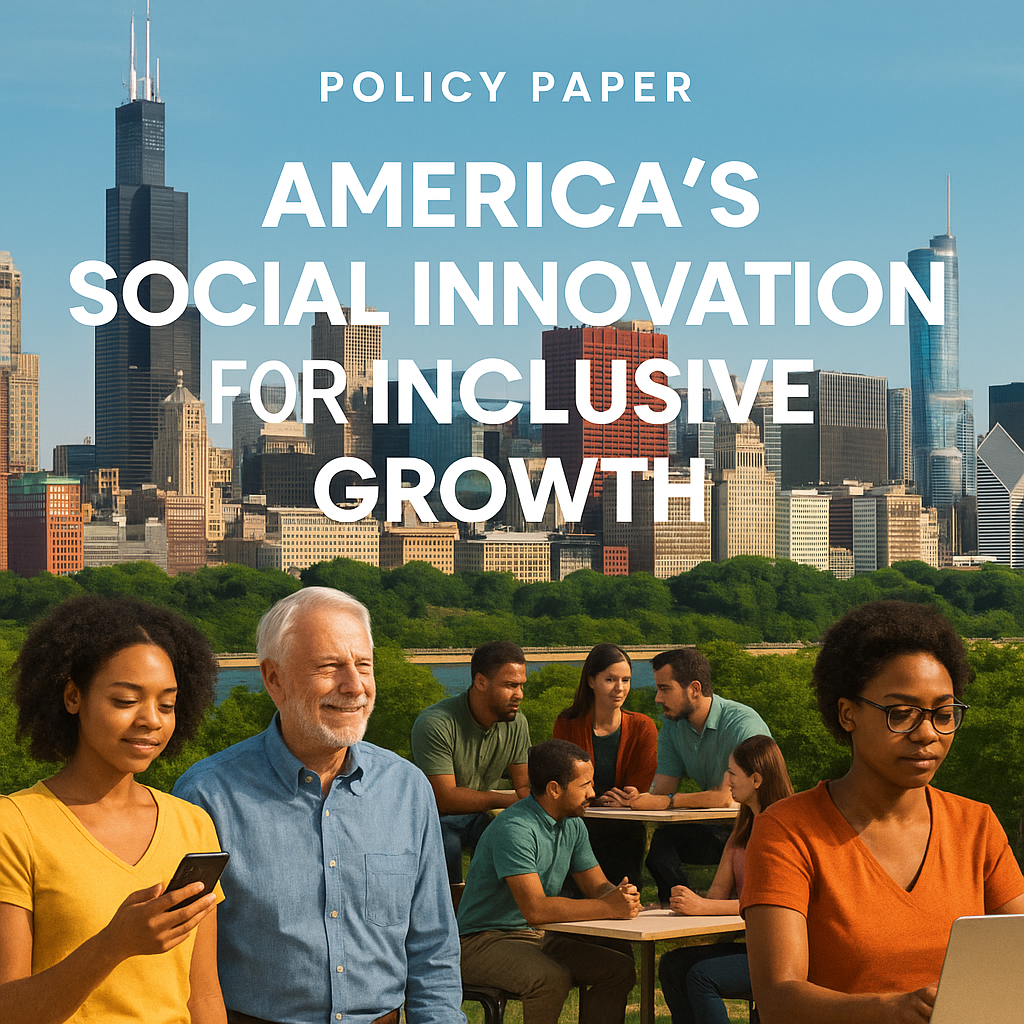Policy Paper
America’s Social Innovation for Inclusive Growth: Lessons for 2025 and Beyond
Executive Summary
The United States is facing deep structural challenges: persistent inequality, declining trust in institutions, uneven access to digital tools, and disparities in education, healthcare, and economic opportunity. Social innovation—locally driven, cross-sector solutions to public challenges—offers a pathway for inclusive growth.
While the U.S. has pioneered innovation ecosystems (Silicon Valley, research universities, philanthropy), it often falls short in ensuring that innovation reaches vulnerable populations. By learning from both domestic models and international examples, the U.S. can harness social innovation to build a more inclusive, resilient, and competitive society.
Table of Contents
-
Introduction: Why Social Innovation Matters for the U.S.
-
Defining Social Innovation & Inclusive Growth in the American Context
-
Drivers of U.S. Transformation in 2025
-
Case Studies of Social Innovation in the U.S.
-
Traits of Transformational American Leaders
-
Enablers: Policy, Institutional, and Cultural Foundations
-
Barriers & Risks Facing U.S. Social Innovation
-
Policy Recommendations for America
-
Measuring Impact & Scaling Solutions
-
Conclusion
1. Introduction: Why Social Innovation Matters for the U.S.
The U.S. is the world’s largest economy and an innovation powerhouse, yet income inequality is at its highest level in 50 years (Pew Research, 2020). Rural communities, communities of color, and low-income households often remain excluded from the benefits of technological and social progress.
To remain globally competitive and socially cohesive, America must not only invest in technological modernization but also ensure that innovation is inclusive.
2. Defining Social Innovation & Inclusive Growth in the American Context
-
Social Innovation (U.S. lens): New models that address entrenched social problems (e.g., housing, healthcare, workforce) by leveraging technology, partnerships, and community participation.
-
Inclusive Growth: Economic expansion that reduces disparities across race, gender, geography, and class—ensuring that prosperity is broadly shared.
3. Drivers of U.S. Transformation in 2025
-
Digital disruption: AI, automation, and big data transforming jobs and services.
-
Climate transition: Expansion of clean energy, EVs, and resilience investments.
-
Demographic shifts: Increasing diversity, aging populations.
-
Social inequities: Gaps in wealth, education, and healthcare access.
-
Crisis learning: Lessons from COVID-19 highlighted innovation’s role in public health (e.g., Operation Warp Speed).
4. Case Studies of Social Innovation in the U.S.
-
Harlem Children’s Zone (New York): Comprehensive cradle-to-career model addressing education, health, and community development. Widely cited as a scalable model.
-
Code for America: Nonprofit using technology to improve government services and expand access to benefits like SNAP.
-
MIT Solve (Massachusetts): Platform linking entrepreneurs with funding to scale innovations for social impact.
-
Rural Broadband Initiatives: Public-private partnerships expanding connectivity in underserved areas, crucial for inclusive digital transformation.
-
Clean Energy Workforce Training (California & Michigan): Programs retraining workers from fossil fuel industries into green jobs.
5. Traits of Transformational American Leaders
-
Equity-focused visionaries: Leaders who prioritize reducing disparities.
-
Bridge-builders: Capable of working across partisan divides.
-
Tech-literate innovators: Understanding AI, digital platforms, and green technologies.
-
Community-grounded: Leaders with strong ties to grassroots movements.
-
Resilient and adaptive: Able to lead during crises.
6. Enablers: Policy, Institutional, and Cultural Foundations
-
Federal programs like Justice40 directing climate investments to disadvantaged communities.
-
World-class universities and R&D ecosystems.
-
Philanthropy and impact investing (Ford Foundation, Rockefeller Foundation, etc.).
-
Strong entrepreneurial culture and access to venture capital.
-
Civil society activism and community-based organizations.
7. Barriers & Risks Facing U.S. Social Innovation
-
Political polarization undermining continuity of initiatives.
-
Unequal access to capital for women, minority, and rural innovators.
-
Digital divide leaving millions without reliable internet.
-
Short-term funding models that discourage sustainable growth.
-
Fragmented federal-state responsibilities, creating inefficiencies.
8. Policy Recommendations for America
-
Establish a National Social Innovation Council to coordinate federal, state, and private initiatives.
-
Expand blended finance models that combine federal funds with private and philanthropic capital.
-
Scale broadband access and ensure digital literacy nationwide.
-
Invest in inclusive entrepreneurship with targeted funding for women, minority, and rural innovators.
-
Support workforce transition with national retraining programs in green and digital sectors.
-
Incorporate social innovation metrics into policy evaluation (equity, community impact, resilience).
-
Foster bipartisan frameworks that shield social innovation from political swings.
9. Measuring Impact & Scaling Solutions
-
Metrics: employment created, poverty reduction, health outcomes, digital access, equity improvements.
-
Evaluation systems: combine quantitative and qualitative methods, with community participation.
-
Scaling strategies: federal incentives, replicable models, open-source platforms.
10. Conclusion
From five decades of studying transformation globally, I believe America’s future lies in its ability to innovate inclusively. Social innovation is not peripheral but central to building trust, competitiveness, and equity.
By learning from both domestic successes and international models, America can build a blueprint where growth is not just faster—but fairer.
References
-
Pew Research (2020). Trends in Income and Wealth Inequality. (pewresearch.org)
-
White House (2022). Justice40 Initiative. (whitehouse.gov)
-
Code for America. Annual Impact Report. (codeforamerica.org)
-
Harlem Children’s Zone. Model & Impact. (hcz.org)
Check out the GTF Research
Check out events
Connect with us on facebook
connect with us on linkedIn
Check out the American Transformation forum
